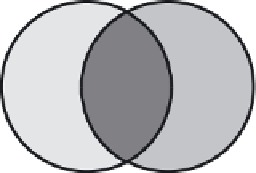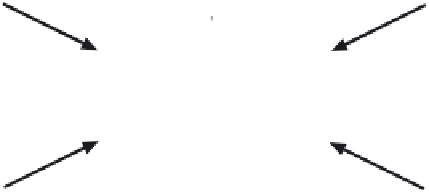Agriculture Reference
In-Depth Information
Circle A:
Adaptations possessed
by the animal
Circle B:
Challenges faced
by the animal in
its current
circumstances
2. Challenges for
which the animal
lacks corresponding
adaptations
1. Adaptations that no
longer serve an important
function
3. Challenges for which the
animal has corresponding
adaptations
Figure 8.2
Many of the welfare challenges in contemporary farming occur either because the
animal has an adaptation that no longer can find a function in modern rearing systems or because
the animal lacks adaptations to such systems (after Fraser
et
al
. 1997).
because the animal has an adaptation that can no longer find a function in modern rearing
systems or because the animal lacks adaptations to such systems (Fraser
et
al
. 1997, Figure 8.2).
Thus, the stress caused because the animal lacks adaptive strategies to handle the situation
(e.g. a noisy fan in the pig house) may be considered worse than the stress outdoor pigs experi-
ence with the fox sneaking around their paddock, since animals in the wild are primed to deal
with unpredictable conditions, of which predators are an important part. This should by no
means stop farmers from protecting their piglets from foxes (albeit by other means than by
eradicating the fox population, since the means used must comply with the ecocentric frame-
work). However, the pigs would have to live with the possibility of being exposed to this kind
of stress, which should not be the case with the noisy fan. It could, of course, be questioned
whether it would be a valuable experience for the pigs, in the sense discussed by Vaarst
et
al
.
(2000), but it would expose the animals to a wider range of experiences, and add 'excitements'
that would still be within their genetic adaptation. Thus, in Figure 8.2 the fan would represent
a 'type 2 challenge', whereas the fox would be a 'type 3 challenge'.
The ecocentric philosopher Holmes Rolston (1988) suggested handling the dilemma of
animal suffering through applying 'a homologous principle' in animal husbandry: 'Do not
cause inordinate suffering, beyond those orders of nature from which the animals were taken.
[…] Culturally imposed suffering must be comparable to ecologically functional suffering.'
The same view can be found in the organic farming movement (Lund 1996). The organic
understanding of animal welfare differs somewhat from that commonly used in conventional
farming, where the biological functioning approach is usually seen as the norm. Researchers
also prefer the latter approach, since it makes it comparatively easy to quantify welfare states.
Therefore to some extent, the criticism of animal welfare in organic farming may stem
from a different understanding of what welfare is. While organic farmers may believe their
chickens have good welfare because they have a (relatively) free life in an environment that
allows them to perform most of their natural behaviours, the conventional farmer or scientist
may focus on the risk of parasite infections, predator attacks, cannibalism and the home-
grown feed with low content of certain essential amino acids. From their point of view, the
welfare of these animals is being compromised.
Is there a general welfare problem in organic production systems?
Several issues must be considered when trying to answer the question of whether there is a
general animal welfare problem in organic production systems. The first one is the issue of





